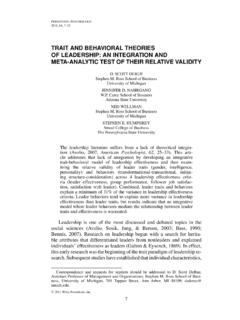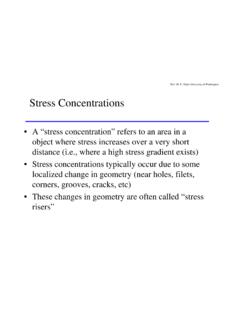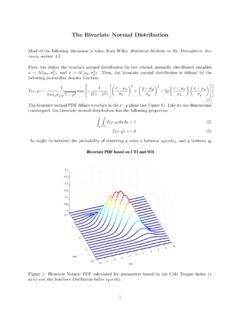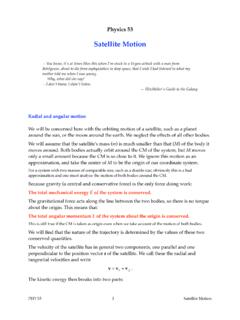Transcription of The Phase Plane Phase Portraits of Linear Systems
1 2008 Zachary S Tseng D 2 1 The Phase Plane Phase Portraits ; type and stability classifications of equilibrium solutions of Systems of differential equations Phase Portraits of Linear Systems Consider a Systems of Linear differential equations x = Ax. Its Phase portrait is a representative set of its solutions, plotted as parametric curves (with t as the parameter) on the Cartesian Plane tracing the path of each particular solution (x, y) = (x1(t), x2(t)), < t < . Similar to a direction field, a Phase portrait is a graphical tool to visualize how the solutions of a given system of differential equations would behave in the long run. In this context, the Cartesian Plane where the Phase portrait resides is called the Phase Plane . The parametric curves traced by the solutions are sometimes also called their trajectories. Remark: It is quite labor intensive, but it is possible to sketch the Phase portrait by hand without first having to solve the system of equations that it represents.
2 Just like a direction field, a Phase portrait can be a tool to predict the behaviors of a system s solutions. To do so, we draw a grid on the Phase Plane . Then, at each grid point x = ( , ), we can calculate the solution trajectory s instantaneous direction of motion at that point by using the given system of equations to compute the tangent / velocity vector, x . Namely plug in x = ( , ) to compute x = Ax. In the first section we will examine the Phase portrait of Linear system of differential equations. We will classify the type and stability the equilibrium solution of a given Linear system by the shape and behavior of its Phase portrait. 2008 Zachary S Tseng D 2 2 Equilibrium Solution ( Critical Point, or Stationary Point) An equilibrium solution of the system x = Ax is a point (x1, x2) where x = 0, that is, where x1 = 0 = x2 . An equilibrium solution is a constant solution of the system, and is usually called a critical point.
3 For a Linear system x = Ax, an equilibrium solution occurs at each solution of the system (of homogeneous algebraic equations) Ax = 0. As we have seen, such a system has exactly one solution, located at the origin, if det(A) 0. If det(A) = 0, then there are infinitely many solutions. For our purpose, and unless otherwise noted, we will only consider Systems of Linear differential equations whose coefficient matrix A has nonzero determinant. That is, we will only consider Systems where the origin is the only critical point. Note: A matrix could only have zero as one of its eigenvalues if and only if its determinant is also zero. Therefore, since we limit ourselves to consider only those Systems where det(A) 0, we will not encounter in this section any matrix with zero as an eigenvalue. 2008 Zachary S Tseng D 2 3 Classification of Critical Points Similar to the earlier discussion on the equilibrium solutions of a single first order differential equation using the direction field, we will presently classify the critical points of various Systems of first order Linear differential equations by their stability.
4 In addition, due to the truly two dimensional nature of the parametric curves, we will also classify the type of those critical points by their shapes (or, rather, by the shape formed by the trajectories about each critical point). Comment: The accurate tracing of the parametric curves of the solutions is not an easy task without electronic aids. However, we can obtain very reasonable approximation of a trajectory by using the very same idea behind the direction field, namely the tangent line approximation. At each point x = (x1, x2) on the ty Plane , the direction of motion of the solution curve the passes through the point is determined by the direction vector ( the tangent vector) x , the derivative of the solution vector x, evaluated at the given point. The tangent vector at each given point can be calculated directly from the given matrix vector equation x = Ax, using the position vector x = (x1, x2). Like working with a direction field, there is no need to find the solution first before performing this approximation.
5 2008 Zachary S Tseng D 2 4 Given x = Ax, where there is only one critical point, at (0,0): Case I. Distinct real eigenvalues The general solution is trtrekCekCx212211+=. 1. When r1 and r2 are both positive, or are both negative The Phase portrait shows trajectories either moving away from the critical point to infinite distant away (when r > 0), or moving directly toward, and converge to the critical point (when r < 0). The trajectories that are the eigenvectors move in straight lines. The rest of the trajectories move, initially when near the critical point, roughly in the same direction as the eigenvector of the eigenvalue with the smaller absolute value. Then, farther away, they would bend toward the direction of the eigenvector of the eigenvalue with the larger absolute value The trajectories either move away from the critical point to infinite distant away (when r are both positive), or move toward from infinite distant out and eventually converge to the critical point (when r are both negative).
6 This type of critical point is called a node. It is asymptotically stable if r are both negative, unstable if r are both positive. 2008 Zachary S Tseng D 2 5 Two distinct real eigenvalues, both of the same sign Type: Node Stability: It is unstable if both eigenvalues are positive; asymptotically stable if they are both negative. 2008 Zachary S Tseng D 2 6 2. When r1 and r2 have opposite signs (say r1 > 0 and r2 < 0) In this type of Phase portrait, the trajectories given by the eigenvectors of the negative eigenvalue initially start at infinite distant away, move toward and eventually converge at the critical point. The trajectories that represent the eigenvectors of the positive eigenvalue move in exactly the opposite way: start at the critical point then diverge to infinite distant out. Every other trajectory starts at infinite distant away, moves toward but never converges to the critical point, before changing direction and moves back to infinite distant away.
7 All the while it would roughly follow the 2 sets of eigenvectors. This type of critical point is called a saddle point. It is always unstable. 2008 Zachary S Tseng D 2 7 Two distinct real eigenvalues, opposite signs Type: Saddle Point Stability: It is always unstable. 2008 Zachary S Tseng D 2 8 Case II. Repeated real eigenvalue 3. When there are two linearly independent eigenvectors k1 and k2. The general solution is x = C1 k1 e rt + C2 k2 e rt = e rt(C1 k1 + C2 k2 ). Every nonzero solution traces a straight line trajectory, in the direction given by the vector C1 k1 + C2 k2. The Phase portrait thus has a distinct star burst shape. The trajectories either move directly away from the critical point to infinite distant away (when r > 0), or move directly toward, and converge to the critical point (when r < 0). This type of critical point is called a proper node (or a starl point).
8 It is asymptotically stable if r < 0, unstable if r > 0. Note: For 2 2 Systems of Linear differential equations, this will occur if, and only if, when the coefficient matrix A is a constant multiple of the identity matrix: A = = 001001, = any nonzero constant*. * In the case of = 0, the solution is = + =21211001 CCCCx. Every solution is an equilibrium solution. Therefore, every trajectory on its Phase portrait consists of a single point, and every point on the Phase Plane is a trajectory. 2008 Zachary S Tseng D 2 9 A repeated real eigenvalue, two linearly independent eigenvectors Type: Proper Node (or Star Point) Stability: It is unstable if the eigenvalue is positive; asymptotically stable if the eigenvalue is negative. 2008 Zachary S Tseng D 2 10 4. When there is only one linearly independent eigenvector k. Then the general solution is x = C1 k e rt + C2 (k t e rt + e rt).
9 The Phase portrait shares characteristics with that of a node. With only one eigenvector, it is a degenerated looking node that is a cross between a node and a spiral point (see case 6 below). The trajectories either all diverge away from the critical point to infinite distant away (when r > 0), or all converge to the critical point (when r < 0). This type of critical point is called an improper node. It is asymptotically stable if r < 0, unstable if r > 0. 2008 Zachary S Tseng D 2 11 A repeated real eigenvalue, one linearly independent eigenvector Type: Improper Node Stability: It is unstable if the eigenvalue is positive; asymptotically stable if the eigenvalue is negative. 2008 Zachary S Tseng D 2 12 Case III. Complex conjugate eigenvalues The general solution is ()())cos()sin()sin()cos(21tbtaeCtbtaeCxt t ++ = 5. When the real part is zero. In this case the trajectories neither converge to the critical point nor move to infinite distant away.
10 Rather, they stay in constant, elliptical (or, rarely, circular) orbits. This type of critical point is called a center. It has a unique stability classification shared by no other: stable (or neutrally stable). It is NOT asymptotically stable and one should not confuse them. 6. When the real part is nonzero. The trajectories still retain the elliptical traces as in the previous case. However, with each revolution, their distances from the critical point grow/decay exponentially according to the term e t. Therefore, the Phase portrait shows trajectories that spiral away from the critical point to infinite distant away (when > 0). Or trajectories that spiral toward, and converge to the critical point (when < 0). This type of critical point is called a spiral point. It is asymptotically stable if < 0, it is unstable if > 0. 2008 Zachary S Tseng D 2 13 Complex eigenvalues, with real part zero (purely imaginary numbers) Type: Center Stability: Stable (but not asymptotically stable); sometimes it is referred to as neutrally stable.














